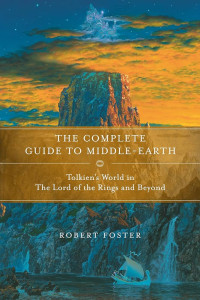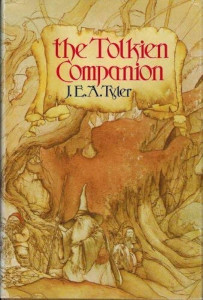 Tolkien’s mythos is complex enough that having a guide or two to it is something that any reader should consider. There are, I doubt not, given the overwhelming popularity of Tolkien right now, dozens of concordances to the legends, history, languages, races, events, and people of J.R.R. Tolkien’s imaginative Middle-Earth, and the two principle works set in it, The Hobbit and The Lord of the Rings. I am going to focus on just two of these publications.
Tolkien’s mythos is complex enough that having a guide or two to it is something that any reader should consider. There are, I doubt not, given the overwhelming popularity of Tolkien right now, dozens of concordances to the legends, history, languages, races, events, and people of J.R.R. Tolkien’s imaginative Middle-Earth, and the two principle works set in it, The Hobbit and The Lord of the Rings. I am going to focus on just two of these publications.
Like Frank Herbert in his Dune series, or Robert Holdstock in his Ryhope Wood sequence, Tolkien was a master at creating a mythos that felt real. In his hands, creations and their true names — those borrowed, such as “hobbit,” or created out of whole cloth — e.g., Ents — came to life, rolling off the page (and our tongues), working their way into our waking and, many times, dreaming lives. They are now real ‘nough that readers cannot imagine a Middle-Earth without a hobbit named Baggins, a dragon called Smaug, or the hissing goblin known as Gollum. And despite the excellent work that Peter Jackson & Company are doing on The Lord of the Rings films, I believe that the books are far better than any film could ever be. Without a book, you cannot curl up in an overstuffed chair on a cold winters night, with a blanket over your legs, a cup of tea at hand, and lose yourself in the images created by reading the text. And much of that magic comes from the language that Tolkien created.
I chose these two reference works because they are contrasting examples of one superb approach (The Tolkien Companion) and one not-very-well-conceived approach (Tolkien’s World from A to Z: The Complete Guide to Middle-Earth) down to and including their respective titles. As a title, the latter simply clunks — no sense of warmth in it ‘tall. It sounds like it was chosen by a bleedin’ committee, not by someone with a sense of literature. Sure as ‘ell wouldn’t get me to pick it off the shelf in the bookstore. It’s also physically smaller than The Tolkien Companion — what a lovely name that is — which is a hardcover as opposed to the trade paper of Tolkien’s World from A to Z. Not to be snotty, but hardcover is better than trade paper if you’re using the thing for reference. I’ll read anything short of shitty mass market paperbacks for fiction, but I really prefer hardcover for me reference collection! I suspect that Tolkien’s World was released specifically to make some quick cash off the The Lord of the Rings mania generated from the movie. Bad lads if this is so! Both lose points on cover art, with the Hildebrandt Brothers art on the one being trite, and the Kevin Reilly being cliched. The 1967 Pan Books has much better artwork — darker, more brooding!
 Now, where The Tolkien Companion really shines as regards art is the illustrated letter for each alphabetical section. They are so superb that I wish we had them on Green Man! There are a few other illos, but they neither add to nor subtract from the value of the book. Nor do the sort of photo-realistic alphabetical headers in the other guide make me feel terribly warm towards the artists, no matter how talented others think they are. Quick — find someone other than the Hildebrandt Brothers to do art for Tolkien-related books!
Now, where The Tolkien Companion really shines as regards art is the illustrated letter for each alphabetical section. They are so superb that I wish we had them on Green Man! There are a few other illos, but they neither add to nor subtract from the value of the book. Nor do the sort of photo-realistic alphabetical headers in the other guide make me feel terribly warm towards the artists, no matter how talented others think they are. Quick — find someone other than the Hildebrandt Brothers to do art for Tolkien-related books!
Ah, but you’ll be wanting to know how the text is. Text? What’s that? (Just joking…) Ok, let’s do a test. What shall we look up? Oh, let’s see what they both say about that dragon called Smaug. The Tolkien Companion lists him as Smaug the Golden, his full, not true, name. (True names are never known, as one controls the being if one knows that name.) His entry starts off thusly: “One of the Greatest Dragons of the Third Age in Middle Earth. A Royal beast of great lineage and cunning, whose first appearance in the Annals of the Age was in the year 2770, when he came flaming out of the North to capture, sack and occupy the Dwarven Kingdom of Erebor…” The other guide says, “Dragon of the Ered Mithrin, the greatest dragon of his time.” Clunk. The latter entry runs a very scant fifty or so words as opposed to the generous three hundred or so words in The Tolkien Companion. Foster’s guide also gets ticked for including specific pages where Smaug appears — useful only if you have the 1993 edition of The Hobbit, published as a Ballantine paperback. Sheesh! My edition, which is the reprinting of the 1966 Houghton Mifflin edition, has different pagination, rendering these references as useful as bullocks on a bull. Tyler rightfully assumes that one has either The Hobbit or The Lord of the Rings in hand and is simply seeking more information. And information is what you get in The Tolkien Companion — a generous serving of lovingly detailed material that will enhance your understanding of these books every bit as much as The Annotated Hobbit will do. Tolkien’s World from A to Z just can’t compare to it!
If you’re just into reading and don’t really care if you get all the somewhat arcane references, you don’t need anything other than the books themselves. In hardcover, of course. But if you really do want to grasp how detailed Tolkien was, and how well-crafted these fictions are, go get The Tolkien Companion now. I for one will keep it alongside me copies of The Hobbit or The Lord of the Rings for those times when knowing how the Dwarves came to be is important.
(Ballantine Books, 1974; reissued in trade format, 2001)
(Pan Books, 1967; Gramercy, 2000)
